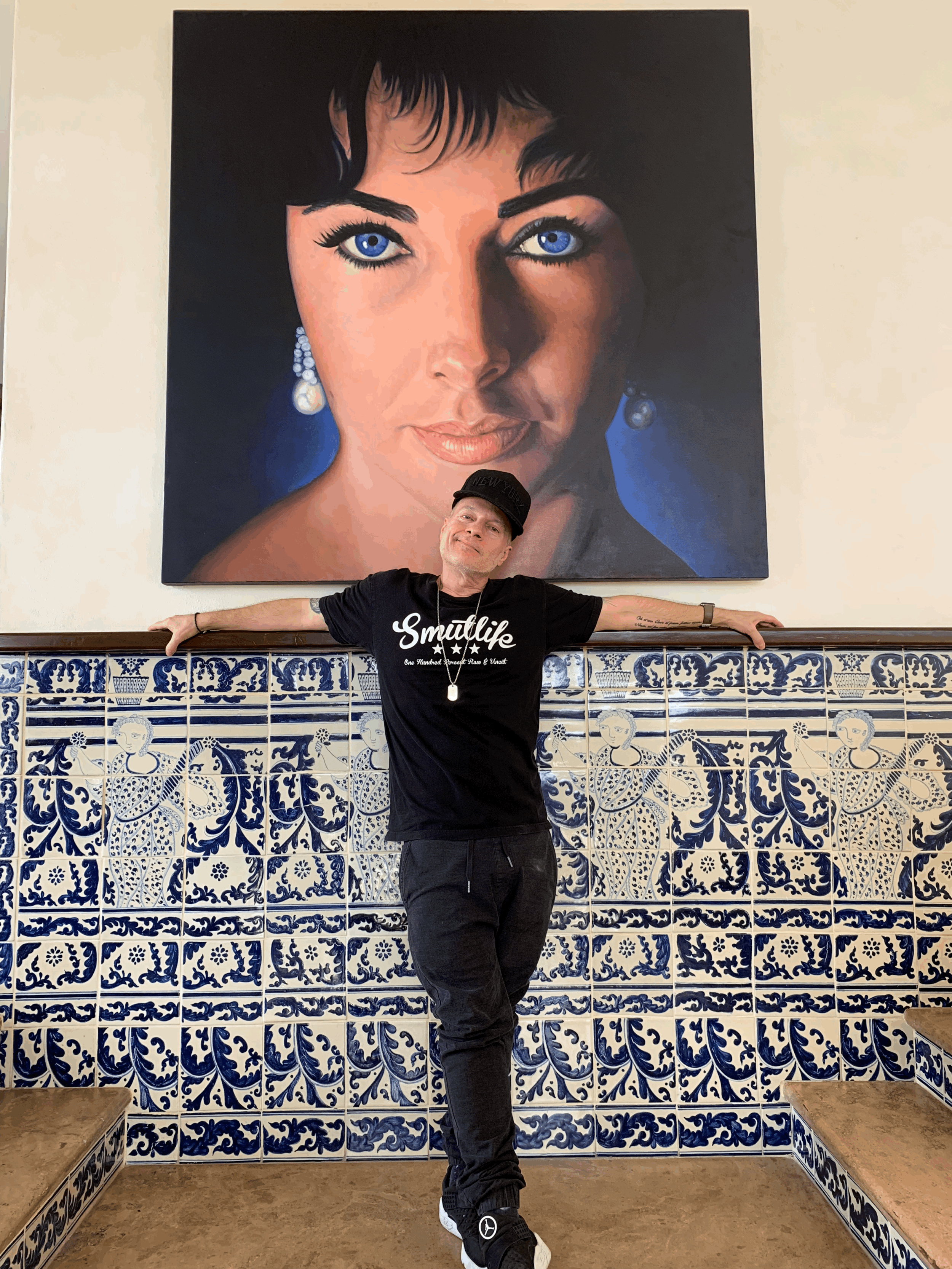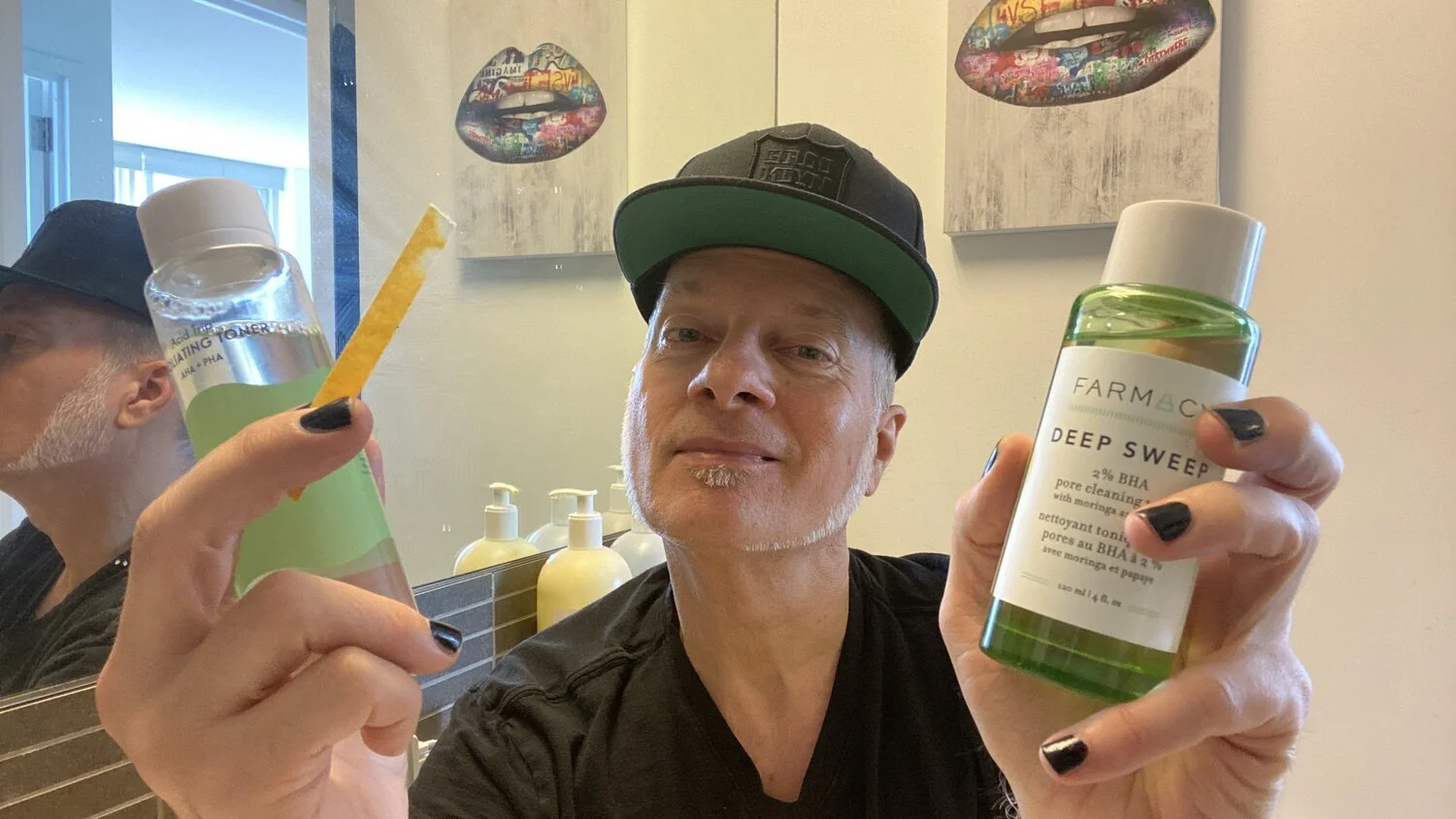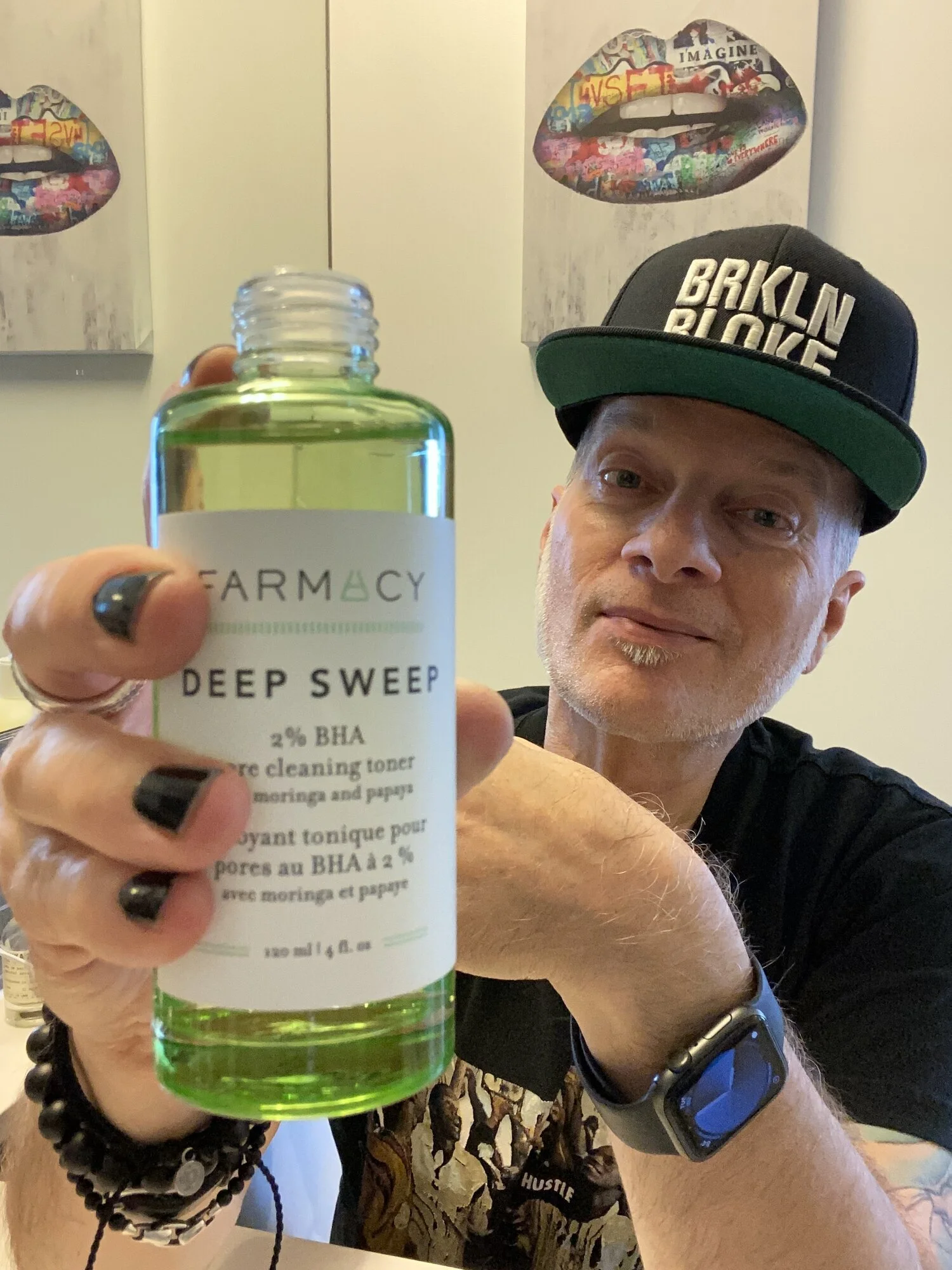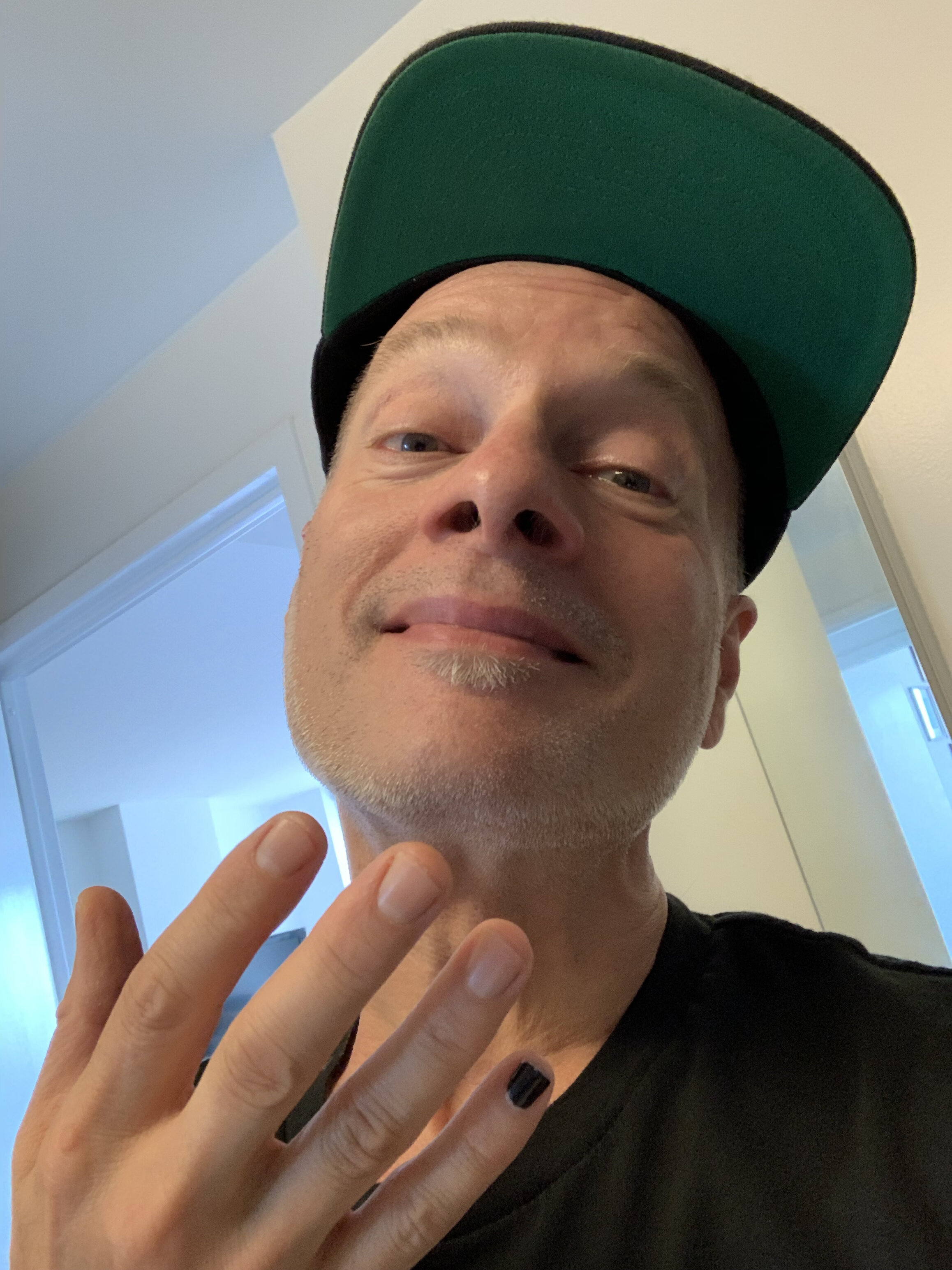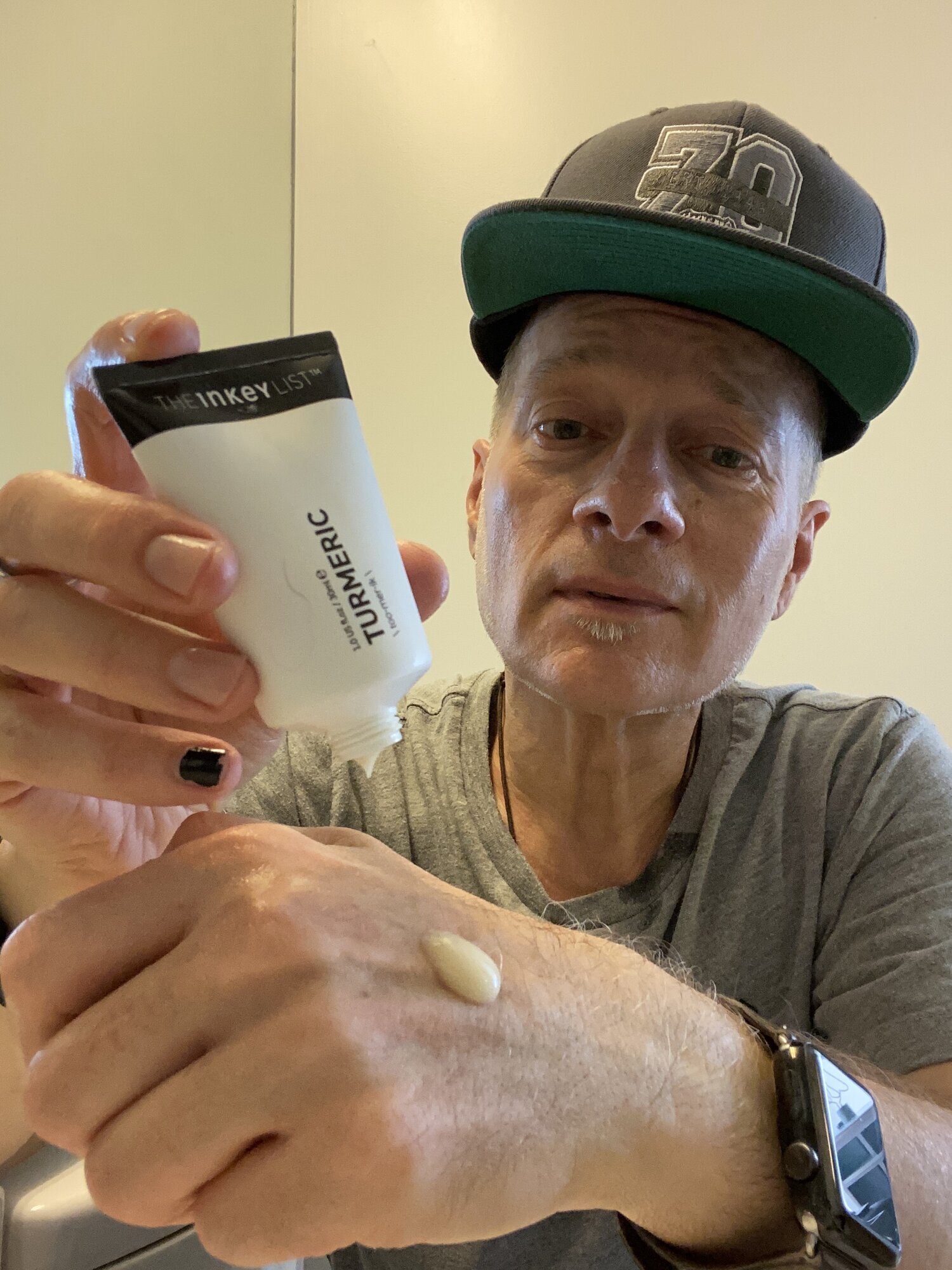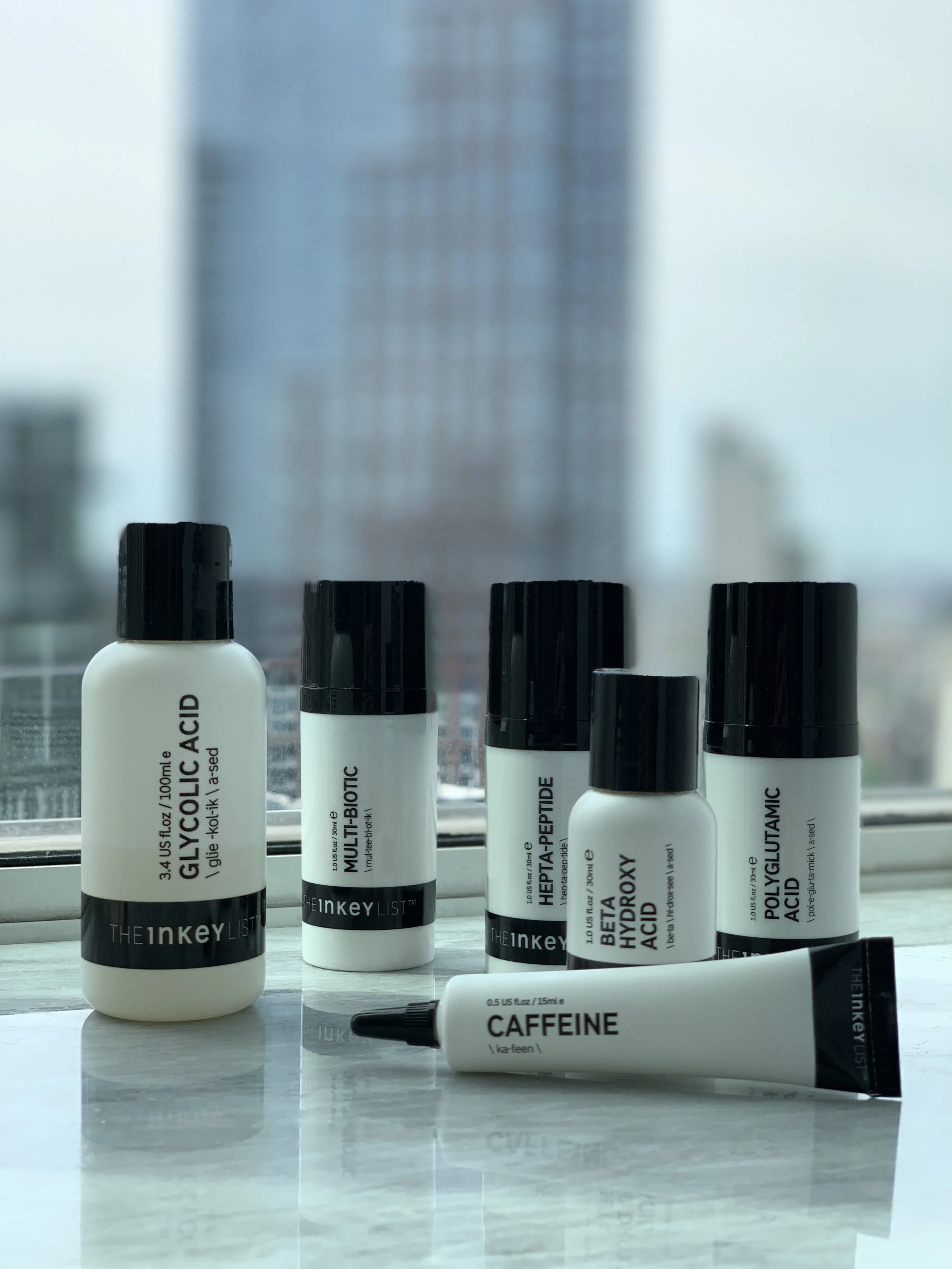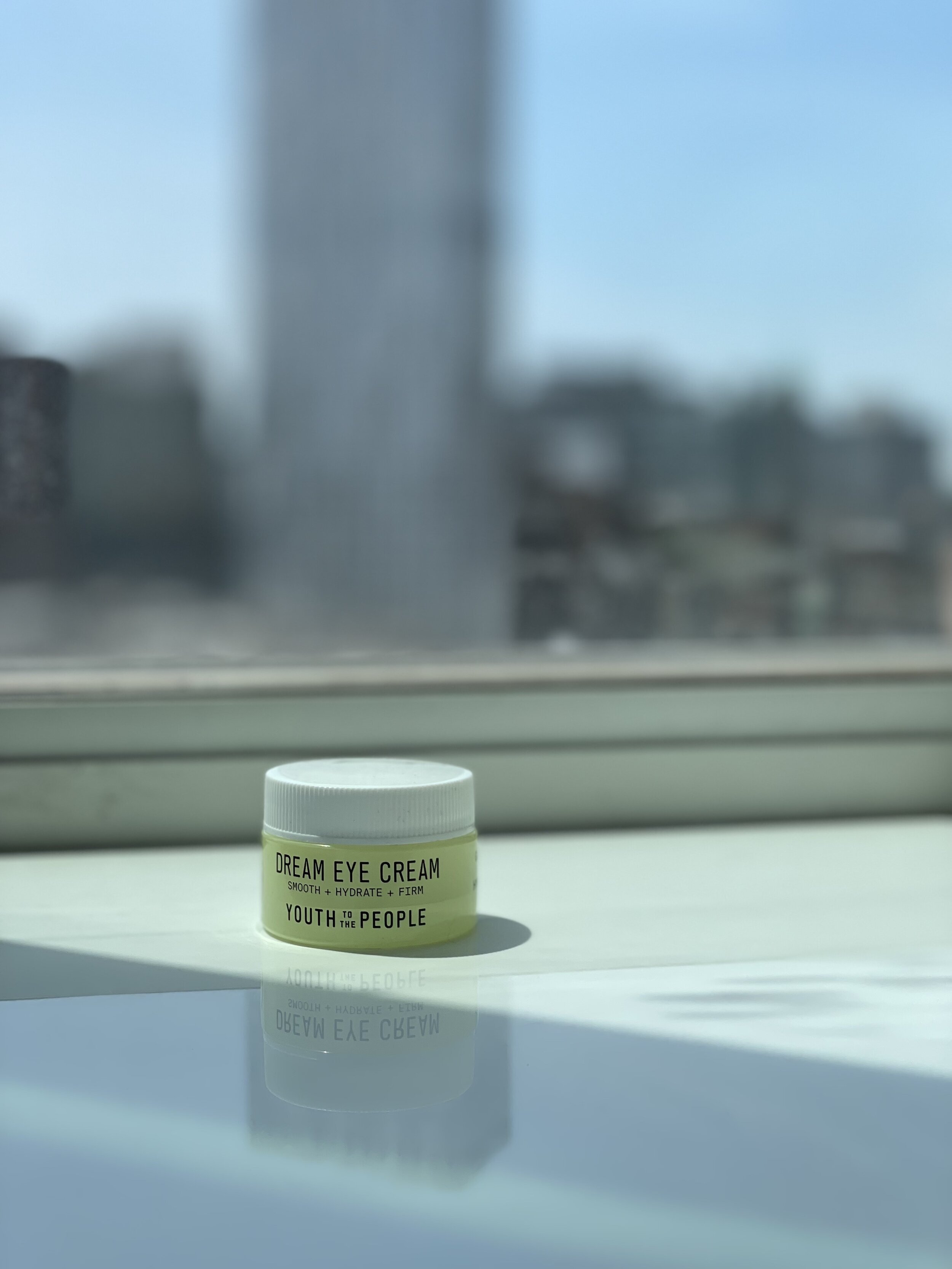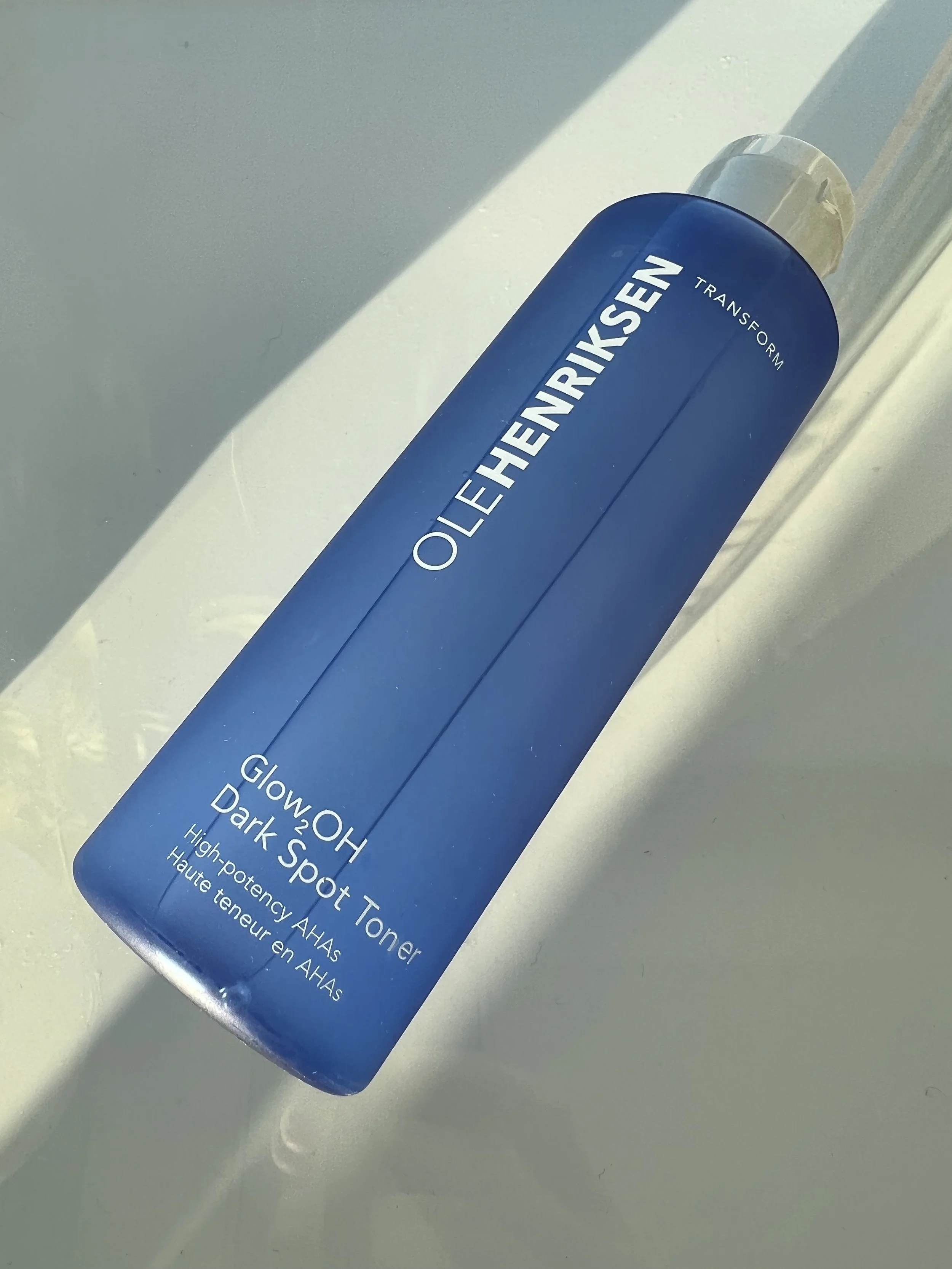SEASONAL SKINCARE TRANSITIONING: TREATMENT TONERS I LOVE THAT MAKE ME EXCITED FOR COLD WEATHER – BEST EXFOLIATING TONER, BEST TONER WITH GLYCOLIC ACID
Like just about everyone else on the planet, I haven’t had a vacation in two years. Or is it more than that? It’s all such a blur.
The last time I went on a real vacation, that wasn’t just a long weekend to somewhere warm, was sometime in 2019. I think it was the early fall, probably September — so more than two whole years ago.
I left the country on an relaxing trip to Puerto Vallarta — a small, progressive town on the west coast of Mexico. When I lived in LA back in the 90s and very early 2000s, Puerto Vallarta was the quickest, easiest, and chillest of escapes from the insanity.
One of my besties met me there and we stayed at this gorgeous boutique hotel that was once Elizabeth Taylor’s villa. All white, mosaic tile everywhere, and every room has its own balcony with a magnificent view of the city. As I recall, it’s called Casa Kimberly. How that name has anything to do with Elizabeth Taylor is beyond me, but there’s a massive mural of the legendary actress in the front lobby. (See just below!)
So it’s almost poetic that I’m headed back to Mexico next weekend for my second real vacation in as many years. This time it’s to the opposite coast of Mexico and the resort town of Cancun. And, even more poetic is the fact that I traveled to Palm Springs, California, this past weekend to stay with that very same friend.
Oh, the Universe…
The skincare stuff starts here.
With the change of seasons here in New York City, I make a habit of switching up my skin care. I like to refer to it as “seasonal skincare transitioning.” As the seasons change, so does your skin — and your skin’s everyday needs.
I love switching up my skin care. And I love toners most of all!
The funny thing about toners is not all toners are created equal — or do the same thing. There are two major types of toners: hydrating toners and acid, or treatment toners. The two are not mutually exclusive; that is, you don’t use one or the other. While they’re both called toners, they have completely distinct purposes and benefits for the skin.
Every skincare routine, morning and evening, should consist of a hydrating toner — applied immediately following cleansing. Period. End of story. Hydration is a must, central to a K-beauty routine and IMO essential to a robust and healthy skincare regimen.
PRODUCT REVIEW: INDIE LEE COQ-10 TONER - BEST HYDRATING TONER, BEST ANTIOXIDANT TONER
A treatment toner, on the other hand, is formulated with any number of beneficial exfoliating acids — usually one or more actives from the class of AHA, BHA or PHA hydroxy acids. After employing a hydrating toner, if you want to use a treatment toner to exfoliate and boost skin’s desquamation process, you can.
There are so many things I love about skincare and how skincare products work with the skin. But there’s one entire skincare habit which, while popular, is quite out of control. And that’s exfoliation and the overuse of exfoliating treatments.
Unlike so much of what we do for our skin — including moisturizing, cleansing and protecting from sun damage — the one thing skin does pretty well on its own is what’s termed desquamation.
Every skin cell originating in the lower levels of the skin rises to the surface within 28 days, where it’s freed from the body — like pollen gently floating from wild poppy flowers and disappearing into the air over the horizon.
What Does Desquamation Mean and Why Does Desquamation Occur?
In short, desquamation is the fancy term for cell regeneration, cell death and exfoliation. More specifically, desquamation is the process by which the skin generates new skin cells and 28 days or so later, sheds them. Desquamation essentially encompasses the life cycle of a skin cell.
There’s an excellent, insightful piece on the Very Well Health website titled, Desquamation Process and the Outer Layer of Skin.
According to the health site Very Well Health:
Desquamation is the natural process in which skin cells are created, sloughed away, and replaced. The desquamation process happens in the outermost layer of the skin called the epidermis. The epidermis itself has four unique layers. Each of these layers plays a role in desquamation.
Skin Cells are Born
Sometimes called cell turnover, desquamation happens every second of the day, without you even noticing.
New skin cells are created in the stratum germinativum, which is the deepest layer of the epidermis. This layer is also called the basal layer.
Skin cells begin their life as a single layer of thick, column-shaped cells. These cells are responsible for creating every cell of your skin.
The cells in this layer divide. Half of them stay behind in the stratum germinativum. The other cells begin their migration to the skin's surface.
Cells Reach the Surface, Then Slough Off
The skin cells have reached their final destination — the stratum corneum. Once the cells arrive at this uppermost layer of the skin they are essentially dead.
The cells in the stratum corneum are very flat and tightly packed. These flat, dead cells continuously fall away as newer cells push their way to the surface. In this way, your skin is constantly renewing itself.
Where do all of those dead skin cells go? You might be surprised to know that most of the dust in your home is actually made up of dead skin cells.
The entire desquamation process, from cell birth to sloughing away, takes approximately 14 to 28 days.
Because the desquamation process is so efficient and methodical, I don’t believe skin needs or can generally tolerate daily exfoliation — whether chemical or physical. Even if your skin tolerates it, it doesn’t need it very often. In fact, our skin doesn’t need us to do anything when it comes to exfoliation.
For the record, I don’t use a chemical exfoliant — either a treatment toner or acid-powered serum — more than thrice weekly.
That said, the kind of exfoliation you can achieve with popular, iconic products like the Sunday Riley Good Genes All-In-One Lactic Acid Treatment or my personal fave Paula’s Choice Skin Perfecting 2% Bha Liquid Exfoliant helps to speed up the process of desquamation. Doing so, leaves the complexion free of dead skin. Dead skin cells aren’t doing you any favors.
PRODUCT REVIEW: PAULA’S CHOICE SKIN PERFECTING 2% BHA LIQUID EXFOLIANT – BEST EXFOLIATING TREATMENT
Truth is, dead skin is simply not as reflective as fresh skin, meaning the natural build-up of dead surface skin cells can result in a lackluster complexion — the opposite of the coveted glass skin. Exfoliating treatments brighten the complexion by immediately removing dead skin cells so skin naturally glows. Even healthy skin can appear dull. And who wants that?
Dead surface skin cells also inhibit the penetration of topical skincare, meaning even the Vitamin C serums and best face creams with Retinol cannot be as effective as you want them to be. And the dead skin lingering on your face is the reason. The level of chemical exfoliation you get from a great treatment or acid toner is the perfect solution.
A caveat about physical exfoliation:
As is the case with skin care in general, not all exfoliating products are good for your skin. In fact, physical exfoliators, or face scrubs, can be quite aggressive on the skin and can scratch and otherwise damage the delicate skin barrier.
If you’re using a face scrub, please stop.
Always a terrific resource for skincare tips, education, insights and guidance, the Paula’s Choice website features an excellent article titled, Exfoliation: The Skin Care Step You Never Knew You Needed.
In the piece, the experts on the Paula’s Choice Research Team seek to educate on the differences between chemical and physical exfoliation and the dangers of using a scrub.
“Daily, gentle exfoliation with a leave-on product is a complete game-changer for every skin type and skin concern. Adding this one step to your routine is the fastest, most effective way to get radiant, smooth, hydrated, blemish-free, even-toned skin.
“AHA (alpha hydroxy acid) and BHA (beta hydroxy acid) exfoliants help skin shed dead cells more quickly, the way it did before age and environmental factors began to slow that process. These acids are also the gentlest way to exfoliate, and they nourish and transform the look of your skin in ways no brush or scrub can.
“Despite the popularity of facial scrubs, most are too harsh and abrasive; they can cause tiny tears that damage skin over time, even if that damage isn’t immediately visible. Even the best scrubs, while they do have benefits, can’t produce the same results as an AHA or BHA exfoliant.”
While AHA and BHA-powered chemical exfoliators are the best acid treatments available, they’re not always the most gentle. And sometimes are no more exfoliating than a hydrating toner. The potency and efficacy of an acid toner is dependent on the pH level of the formula and which of the six alpha hydroxy acids are being used; the most potent being Glycolic Acid, the least, Mandelic Acid.
Hot in skincare of late is the newest of the hydroxy acid molecules, Poly Hydroxy Acids, or PHA’s. PHA’s are acids that work more slowly with the skin, meaning they’re more gentle — and more favorable for sensitive skin prone to irritation and redness. If you deal with sensitivity, excessive dryness, eczema or rosacea, a PHA-powered treatment would be your best bet. (Psst…more on PHA’s below!)
With that, let’s take a look at some of my new fave treatment toners that are perfect for skincare transitioning as the weather cools down here in NYC…
Farmacy | Deep Sweep 2% Bha Pore Cleaning Toner With Moringa + Papaya
As far as exfoliating treatments go, the Farmacy Deep Sweep 2% BHA Pore Cleaning Toner with Moringa + Papaya is a good, clean acid toner — and among the best Salicylic Acid treatments for face. It’s a safe-for-skin, refreshing, effective formula and a pleasure to use.
With a 2% concentration of Salicylic Acid and a pH of between 3-4, Farmacy’s BHA toner certainly does what a good acid toner should do. It exfoliates the skin and deep cleans — or make that sweeps — pores, clearing them of any build-up that can stretch them and make them appear more visible. As I like to remind people whenever I get the chance, you cannot shrink your pores; rather, you can clarify them so that they appear smaller in size and aren’t as noticeable on the complexion.
Interestingly in the Deep Sweep formula, situated between water and the 2% concentration of Salicylic Acid, is the amino acid Arginine. It seems to come outta left field and I’m not quite sure why the Farmacy chemists included it in Deep Sweep, particularly at that level. But I’m glad they did!
Amino acids are really great for the skin. They’re bio-compatible and are the building blocks of peptides and proteins. They can even help maintain hydration levels and promote skin health. Such miracle workers!
What Are Amino Acids?
Of course, the experts on the Paula’s Choice Research Team have the most informed insights on amino acids:
“There are many amino acids, but most scientists agree that there are 20 that are important to our health, divided into two types: essential and non-essential. The “non-essential” term doesn’t mean that those amino acids aren’t important; rather, it means that your body can make them on its own, so it’s not “essential” for you to get them elsewhere, such as from food or supplements.
“Essential” amino acids, on the other hand, are essential because they must be obtained from foods or supplements; a deficiency in even one of them can result in health problems.
“There are nine essential amino acids: histidine, isoleucine, leucine, lysine, methionine, phenylalanine, threonine, tryptophan, and valine…the 11 non-essential amino acids, which the body can make on its own, include alanine, arginine, asparagine, aspartic acid, cysteine, glutamic acid, glutamine, glycine, proline, serine, and tyrosine.”
Beyond the intriguing inclusion of Arginine in the INCI, there are numerous nourishing ferments and botanical actives in Deep Sweep, including Lactobacillus/Papaya Fruit Ferment Extract, Moringa Oleifera Leaf Water and Extract and Radish Root Ferment Filtrate. There’s also a hint of PHA Gluconolactone, a naturally occurring antioxidant with gentle exfoliating benefits.
Notably missing from the formula are any known skin irritants like denatured alcohol, synthetic preservatives, fragrance or fragrant plant oils. I’ve been really into Farmacy’s Deep Sweep and had been reaching for whilst testing it 2-3 times a week, especially on notably hot, humid days.
What I like about it: I’m so impressed by Farmacy’s Deep Sweep 2% BHA Pore Cleaning Toner and really appreciate the pro-skin health approach, making it useful for all skin types, not just those with oily, acne-prone skin who benefit most from Salicylic Acid.
What I don’t like about it: There’s really nothing I don’t like about it. Even the Eucalyptus Globulus Leaf Water is not an essential oil, which would otherwise be sensitizing to the skin.
Who it’s for: All skin types, but particularly oily and acne-prone skins.
SHOP THE BLOG: Purchase the Farmacy Deep Sweep 2% BHA Pore Cleaning Toner with Moringa + Papaya for $28 here.
SKINCARE 101 : HOW TO WAKE UP GLOWING! (WITH AN AHA, BHA OR PHA OVERNIGHT TREATMENT)
Good Molecules | Glycolic Exfoliating Toner
I love Good Molecules. I think they do a good job of bringing rather well-formulated skincare to us all at very affordable prices. Good Molecules is one of a handful of what I call democratically priced skincare brands; that is, the products are accessible to the broadest range of skincare users.
One of my favorites from Good Molecules is the brand’s superb Niacinamide Brightening Toner contains a high level of Vitamin B3, likely 10%. Niacinamide is a fantastic active and my favorite skincare ingredients. With its many pro-skin health benefits, including the ability to improve the look of enlarged pores, uneven skin tone, fine lines, dullness — Niacinamide is indispensable. And, at very high levels like 20%, it can even have an exfoliating benefit.
PRODUCT REVIEW: GOOD MOLECULES NIACINAMIDE TONER - BEST BRIGHTENING TONER, AMONG THE BEST NIACINAMIDE SERUMS
So I was excited to be among the first to test out the new Good Molecules Glycolic Exfoliating Toner! With a conservative 3.5% concentration of exfoliating Glycolic Acid, the brand’s new Glycolic Exfoliating Toner is great for beginners to acid exfoliation.
As with all Good Molecules products, it’s a clean formula and, in the brand’s push toward full ingredient transparency, the percentage of every active and inactive ingredient in the formula is laid bare for all to see.
I always found it a ridiculous notion that a brand wouldn’t want to disclose the exact levels of ingredients in a formula for fear that the competition could somehow copy it.
Any good chemist should be able to ascertain down to a ballpark concentration, the ingredients in a skincare formula. Knowing the highest level of the actives is usually enough to duplicate a product.
For an acid toner like the Glycolic Exfoliating Toner, there isn’t much of a need for a high level of soothing actives since the level of acids is relatively low. In addition to the 3% Glycolic Acid, there’s a modest 2% concentration of Salicylic Acid and just 0.1% Niacinamide — about 19.9% too little to achieve a legitimate exfoliating effect.
What Is Glycolic Acid and What Does Glycolic Acid Do to Your Face?
There is an insightful article from the experts on the Paula’s Choice Research Team titled, Glycolic Acid: What It Is and Why You Should Use It. In it, the experts expound on the many superb benefits of Glycolic Acid for the skin.
Glycolic Acid Benefits
Using an exfoliant with glycolic acid for your face results in a brighter, more even toned complexion. Like all AHAs, glycolic acid works by helping turn over spent cells on skin’s surface.
This type of exfoliation addresses numerous skin concerns, including sun damage, uneven tone, rough, flaky patches of skin, fine lines, and wrinkles. In higher concentrations, glycolic acid can even improve the look of deeper wrinkles.
Studies also show that glycolic acid significantly increases skin’s hydration. It does this by helping skin make substances like mucopolysaccharides, which help skin stay hydrated by increasing its natural content of hyaluronic acid, which in turn enhances skin’s resilience.
One exciting new note about glycolic acid: emerging research shows it might even protect skin against UV damage (in addition to reducing its damaging after-effects), though more studies need to be done and of course it doesn’t replace the need for sunscreen. Still, it’s a promising development!
Glycolic acid occurs naturally in sugar cane, but is most effective when synthesized in a lab, where its potency and concentration are optimized for use in skin care. Using plant sugars, like sugar maple, for their glycolic acid content is an option, but the bulk of the research on glycolic acid’s benefits for skin is about the synthetic form, because this type can be optimized for effectiveness, purity, stability, and pH, all critical to getting effective glycolic acid products.
Originally a wild-harvested Mediterranean plant, blue tansy — which is actually yellow in color — is now cultivated mainly in Morocco. When the flower’s popularity in beauty products surged, it was harvested almost out of existence in the wild. Today, supplies are steadily increasing, but it’s still one of the more expensive essential oils. A 2-ounce bottle may cost more than $100.
The blooms of Tanacetum annuum are yellow. Its slender leaves are covered with a fine white “fur.” The oil has a sweet, herbal fragrance due to its high camphor content.
The Best Brightening Serums
So, the Glycolic Exfoliating Toner has modest levels of exfoliating actives. That’s fine. It’s not to say that I don’t really like the Glycolic Exfoliating Toner formula. I do. But again, it’s a rather weak treatment toner and well-targeted to a person who’s new to chemical exfoliation.
If you’re just starting out with chemical, or acid exfoliation and want to ease your way into it, the Good Molecules Glycolic Exfoliating Toner is perfect for you. But if you want an extra-ordinary brightening and hydrating toner, don’t sleep on the Good Molecules Niacinamide Brightening Toner. That stuff is everything!
What I like about it: I like that the Good Molecules Glycolic Exfoliating Toner contains a lower level of Glycolic Acid, with a 3.5% concentration. That makes it a great option for a new user of treatment toners.
What I don’t like about it: The insignificant levels of beneficial Salicylic Acid and Niacinamide seem nonsensical to me. Like why bother?
Who it’s for: All skin types, but particularly skins that aren’t accustomed to using harsh chemical acids like Glycolic Acid.
SHOP THE BLOG: Purchase the Good Molecules Glycolic Exfoliating Toner for $14 here.
FOR A LIMITED TIME
ENJOY 10% OFF ALL SKINCARE FROM MAYSAMA BEAUTY
CLICK HERE | DISCOUNT AUTOMATICALLY APPLIED AT CHECKOUT
Maysama Beauty | ABP11+ Green Rooibos Gentle Resurfacing Toner
I first featured Maysama ABP11+ Green Rooibos Gentle Resurfacing Toner on my Instagram page on #skincarmasaturday — a sneak peek at my skincare discoveries of the week. This extra-ordinary treatment toner is a real standout and is among the best exfoliating toners that I’ve tried.
My most recent deep dive into the best treatment toners was last summer in an article titled, Acid Toners – Some of the Best BHA / AHA Toners for Face From Paula's Choice, Farmacy And More. The extensive piece featured two of my all-time favorite acid toners: the Farmacy Deep Sweep 2% BHA Pore Cleaning Toner with Moringa + Papaya and Paula’s Choice Skin Perfecting 2% BHA Liquid Exfoliant — one of the best toners with Salicylic Acid for oily skin.
ACID TONERS – SOME OF THE BEST BHA / AHA TONERS FOR FACE FROM PAULA'S CHOICE, FARMACY AND MORE
Maysama’s ABP11+ Green Rooibos Gentle Resurfacing Toner is made with a 77% acid complex comprising 5% Lactic Acid (AHA), 1% Salicylic Acid (BHA) and a 5% concentration of PHA Gluconolactone — one of the most gentle exfoliating acids on par with Mandelic Acid, the mildest of the alpha hydroxy acids.
Polyhydroxy Acids, or PHA’s, are the latest acid rage in skincare. Many of us (yours truly included!) are guilty of overdoing it with harsh acids like Glycolic Acid. Instead of educating that overuse of acids can sensitize the skin, marketers seized on the fear of many consumers that their skin is sensitive. Most people don’t have sensitive skin; rather, their skin is sensitized.
So, here comes the class of gentler acids called Polyhydroxy Acids, or PHA’s. With long, scientific, and even futuristic names like Gluconolactone, Lactobionic Acid and Galactose, PHA’s have a milder exfoliating benefit and can even help to rehydrate the skin.
What Is Polyhydroxy Acid and How Do PHA’s Work?
I found an insightful piece on the Healthline website titled, Brainy Beauty: What Can PHAs Really Do for Your Skin? Here’s what I found most salient:
Countless beauty brands spend billions every year to make products that “smooth away” wrinkles — with sometimes impressive but always limited results. Polyhydroxy acids (PHAs) are one of the latest trendy beauty ingredients touted to banish fine lines.
Older studies do suggest that PHAs can help hydrate skin and boost skin cell regeneration, which helps reduce the appearance of fine lines and wrinkles. Compared to similar exfoliating ingredients, they’re less irritating, especially if you have sensitive skin.
Here’s what you need to know about PHAs, including how they work, how to use them, and where to find them.
The facts:
Aging has multiple effects on your skin: The epidermis (i.e., the skin’s outermost layer) thickens. The skin holds in less moisture and contains less collagen. Sun exposure further damages cellular DNA. Together, these factors increase the appearance of wrinkles.
PHAs are a chemical exfoliant.
“Exfoliation helps to slough away dead, dull-looking cells, reveal healthy cells, reduce hyperpigmentation, and improve skin texture,” says Dr. Dendy Engelman, a dermatologist practicing at Shafer Clinic in New York City.
PHAs also hydrate skin. They support the skin’s barrier function, which locks in moisture and reduces the appearance of fine lines and wrinkles.
The ingredient boasts other benefits too.
“PHAs potentially facilitate the penetration of other active ingredients applied to treated skin,” says Dr. Tsippora Shainhouse, FAAD, a board certified dermatologist in private practice at SkinSafe Dermatology and Skin Care in Beverly Hills, California.
And PHAs have antioxidant properties that “help undo and prevent UV and pollution-induced free radical damage to collagen and skin cells,” she says.
The result? PHAs have an anti-aging effect, says Shainhouse.
FOR A LIMITED TIME
ENJOY 10% OFF ALL SKINCARE FROM MAYSAMA BEAUTY
CLICK HERE | DISCOUNT AUTOMATICALLY APPLIED AT CHECKOUT
Perhaps the most noteworthy characteristic of the ABP11+ Green Rooibos Gentle Resurfacing Toner is its wonderfully aromatic scent. It smells like freshly brewed tea, likely the result of the high content of tea extracts in the formula, including Kombucha (Black Tea Ferment) and the brand’s signature Aspalathin-enriched Green Rooibos Tea Extract.
It’s like a cuppa pure heaven. In fact, it feels like heaven on the skin. To test any sensitizing effect, I’ve used it twice daily over several days and never noticed anything but a bright, healthy complexion.
You’ve got to experience the Maysama ABP11+ Green Rooibos Gentle Resurfacing Toner for yourself…
What I like about it: Maysama’s ABP11+ Green Rooibos Gentle Resurfacing Toner really is an exceptional blend of pro-skin health goodness. I love the acid oomph in this formula and the inclusion of a high level of hydrating, soothing Aloe Barbadensis Leaf Juice (ingredient number 2!). There’s also about 2% Ascorbic Acid (pure Vitamin C) and Ascorbyl Glucoside — a stable form of vitamin C that more easily penetrates the skin barrier.
What I don’t like about it: I feel that there could be more buffers against irritation. It’s a wonderful formula but quite strong, which means it may not be ideal for sensitive skins.
Who it’s for: All skin types, except the most sensitive skins.
SHOP THE BLOG: For a limited time, save 10% on all skin care from Maysama Beauty with code SKINCARMA10. (Discount automatically applied at checkout.) Purchase the Maysama ABP11+ Green Rooibos Gentle Resurfacing Toner for $59.36 (reg. 65.95) here.
The Inkey List | Polyhydroxy Acid (PHA) Gentle Exfoliating Toner
I guess you could call me an #inkeyfanboy and get away with it. To be honest, I love just about everything that The Inkey List has ever developed. Since the brand launched more than three years ago, they’ve been an innovation machine.
In that time, I’ve reviewed probably two dozen products from The Inkey List. Among my favorites are The Inkey List’s Turmeric Cream, the Oat Cleansing Balm and the brand’s iconic Caffeine Eye Serum — one of the best eye creams for puffiness.
This past year alone, it seems that The Inkey List doubled their product offerings. At last count, there were 32 Inkey products offered on the Sephora website. And I know that’s not everything the brand offers.
Most of the so-called “democratically priced” skincare brands like The Ordinary, Good Molecules and Naturium stick to simple, single-note formulas like a Vitamin C face cream, Glycolic Acid toner or a Hyaluronic Acid serum.
While The Inkey List certainly offers all of the above, the brand likes to tweak the market with cool, innovative products that aren’t going to be bestsellers. Rather, they’re fun and make the brand more interesting beyond its basic black and white packaging.
The Inkey List’s Apple Cider Vinegar Acid Peel is the perfect example. What could be more intriguing and niche than that? Oh, how about a Snow Mushroom Moisturizer? Yup, Inkey has that too!
BRANDS I LOVE: THE INKEY LIST AFFORDABLE SKINCARE - BEST ANTI-AGING SERUMS, BEST ANTI-AGING MOISTURIZERS
It’s hard to believe that The Inkey List offers products that I have never tried. Until recently, I actually hadn’t had the chance to experience The Inkey List’s Polyhydroxy Acid (PHA) Gentle Exfoliating Toner or just PHA Toner for short.
As with many of The Inkey List’s products, the PHA Toner is a relatively simple formulation. With a tight, 16-ingredient-deep INCI, it’s not difficult to ascertain exactly what the product does and who it’s intended for.
As with Maysama’s ABP11+ Green Rooibos Gentle Resurfacing Toner, the PHA Toner from The Inkey List is powered by a solid dose of the most gentle of the hydroxy acids, the PHA Gluconolactone. With a 3% concentration of Gluconolactone, the formula is relatively tame in terms of its exfoliating potency. And unlike the Maysama version, it doesn’t contain any additional exfoliating acids like Lactic or Salicylic.
Beyond that 3% concentration of PHA Gluconolactone, there’s 3% Niacinamide, my favorite antioxidant. Even a three-percent level of Niacinamide twice a day can be beneficial for the skin. It’s not enough on its own though. In my humble opinion, you can’t get enough Niacinamide into your skin each day.
There are, of course, multiple ways to get Niacinamide into your skincare routine — and into your skin. You can go the straight up, cut-to-the-chase route with a dedicated serum like my all-time favorite, the Paula’s Choice 10% Niacinamide Booster. Or, you can get it in smaller doses a little at a time as is the case with The Inkey List Polyhydroxy Acid (PHA) Gentle Exfoliating Toner.
What Is Niacinamide and What Does Niacinamide Do for the Skin?
I found a comprehensive article on Niacinamide written by the skin experts on the Paula’s Choice Research Team, titled simply, How Niacinamide Helps Skin. Here’s an excerpt:
How Niacinamide Helps Skin
Niacinamide is a skin care ingredient worthy of your attention and your skin will love you for using it. Among a handful of other amazing skin care ingredients such as retinol and vitamin C, niacinamide is a standout because of its versatility for almost any skin care concern and skin type.
As many of you know about us, but for those who don’t, the conclusions we make about any ingredient are always based on what the published research has shown to be true—and the research about niacinamide unanimously demonstrates how special it is. New research keeps showing it’s one of the most exciting skin care ingredients around.
What is Niacinamide?
Also known as vitamin B3 and nicotinamide, niacinamide is a water-soluble vitamin that works with the natural substances in your skin to help visibly minimize enlarged pores, tighten lax pores, improve uneven skin tone, soften fine lines and wrinkles, diminish dullness, and strengthen a weakened surface.
Niacinamide also reduces the impact of environmental damage because of its ability to improve skin’s barrier (its first line of defense), plus it also plays a role in helping skin to repair signs of past damage. Left unchecked, this type of daily assault makes skin appear older, dull, and less radiant.
Why You Should Use Niacinamide
As you might have gathered, we’re very impressed with all that niacinamide can do for skin when applied via skin care products like toners, serums, and highly concentrated leave-on treatments. Niacinamide is uniquely compatible with any of the products in your skin care routine, including those that contain retinol, peptides, hyaluronic acid, AHAs, BHA, vitamin C, and all types of antioxidants.
You can use multiple niacinamide-containing products in your routine, and it will still be non-sensitizing as this ingenious B vitamin is well tolerated by all skin types. It’s even suitable for use by those with sensitive or rosacea-prone skin.
Other helpful benefits of niacinamide are that it helps renew and restore the surface of skin against moisture loss and dehydration by helping skin improve its natural production of skin-strengthening ceramides. When ceramides become depleted over time, skin is left vulnerable to all sorts of problems, from persistent patches of dry, flaky skin to increasingly becoming extra-sensitive.
If you struggle with dry skin, topical application of niacinamide has been shown to boost the hydrating ability of moisturizers so skin’s surface can better resist the moisture loss that leads to recurrent dry, tight, flaky skin. Niacinamide works brilliantly with common moisturizer ingredients like glycerin, non-fragrant plant oils, cholesterol, sodium PCA, and sodium hyaluronate.
How does niacinamide help pores? Great question, although the answer here isn’t certain. Simply put, research hasn’t come to a full understanding about how this B vitamin works its pore-reducing magic, but it does! It seems that niacinamide has a normalizing ability on the pore lining, and that this influence plays a role in keeping debris from getting backed up, which leads to clogs and rough, bumpy skin. As the clog forms and worsens, the pores stretch to compensate, and what you’ll see is enlarged pores. By helping things get back to normal, niacinamide use helps pores return to their normal size. Sun damage can cause pores to become stretched, too, leading to what some describe as "orange peel skin". Higher concentrations of niacinamide can help visibly tighten pores by shoring up skin’s supportive elements.
NIACINAMIDE IS THE GAME CHANGER YOU NEED TO DEFEND AGAINST SKIN DAMAGE AND MAINTAIN OPTIMAL SKIN HEALTH
What I like about it: Even though The Inkey List’s PHA Exfoliating Toner is a simple formula, it has a lot of pro-skin health goodness. It gently exfoliates, brightens, soothes — and all that for just about $10. It’s excellent for amping up your routine twice a day.
What I don’t like about it: The low level of the gentlest of the exfoliating acids, PHA Gluconolactone, means this treatment toner will fall short of expectations if you’re looking for more intense exfoliation. That’s said, it’s great for sensitive skin or beginners to chemical exfoliation.
Who it’s for: All skin types, especially sensitive skins.
SHOP THE BLOG: Purchase The Inkey List Polyhydroxy Acid (PHA) Gentle Exfoliating Toner for $10.99 here.
Youth To The People | Mandelic Acid + Superfood Unity Exfoliant
I can’t think of a single Youth To The People product I’ve tried that I didn’t really love. The brand has such a great, laid back vibe that’s reminiscent of my days in Los Angeles. And, come to think of it, Youth To The People is from Los Angeles!
I’ve reviewed many, many of the cleanly formulated brand’s products — including the Youth to the People Adaptogen Deep Moisture Cream and the Superfood Air-Whip Moisturizer with Hyaluronic Acid — one of the best face creams for oily skin.
Despite the fact that it’s in a jar, the Youth To The People Dream Eye Cream with Goji Stem Cell and Ceramides remains one of my favorite product discoveries of 2021 — and is certainly among the best eye creams for dry skin, oily skin and every skin in between.
PRODUCT REVIEW: YOUTH TO THE PEOPLE DREAM EYE CREAM- BEST ANTI-AGING EYE CREAM, BEST EYE CREAM FOR OILY SKIN
So of course I eagerly anticipated the introduction of the brand’s new treatment toner — the Youth To The People Mandelic Acid + Superfood Unity Exfoliant. And in classic Youth To The People fashion, the formula is a winner in my book.
In fact, I’d go out in a limb and say that I saved the best for last. It’s that good.
Youth To The People’s Superfood Unity Exfoliant is a powerhouse treatment toner with sensitive and sensitized skin in mind. The formula blends two gentle, effective exfoliating acids, the PHA Gluconolactone and the least aggressive of the alpha hydroxy acids, Mandelic Acid.
Mandelic Acid hasn’t gotten the time in the light that it deserves and it’s only been very recently that brands have begun to use it for its gentle exfoliating efficacy. For the longest time, of course, The Ordinary kind of dominated the Mandelic game with its unsung hero, Mandelic Acid 10% + HA.
What Is Mandelic Acid and What Does Mandelic Acid Do for the Skin?
There’s a very succinct, well-sourced explanation of Mandelic Acid and its exceptional benefits for the skin, and particularly sensitive skin, from the experts on the Paula’s Choice Research Team. Here’s what they have to say…
Mandelic Acid at a Glance
Also known as amygdalic acid
An alpha hydroxy acid (AHA) that can exfoliate skin
Generally more tolerable for those with sensitive skin
Must be in opaque packaging to maintain its effectiveness
Mandelic Acid Description
Mandelic acid is a type of alpha hydroxy acid (AHA). There’s some research showing mandelic acid is an effective exfoliant, although it’s not as effective as glycolic acid due to its larger size (it’s twice as big as glycolic acid) and slower penetration into skin; however, these traits can also make mandelic acid more tolerable for those with sensitive skin. Unlike glycolic acid, mandelic acid is light-sensitive and must be packaged in an opaque container to remain effective. It may be synthetic or derived from almonds. Like other AHAs, mandelic acid is most effective in leave-on products that are within a 3-4 pH range.
A couple studies have shown that mandelic acid and salicylic acid worked well together in a higher-strength peel for use on darker skin tones struggling with discolorations, including post-acne marks. However, what we don’t know is how well mandelic acid would’ve worked on its own—it’s possible the results were more from salicylic acid than the combination of the two acids. Other research has shown mandelic acid can increase sebum (oil) production, which isn’t great for oily skin but would be a benefit for dry skin.
Mandelic Acid References
Journal of the American Academy of Dermatology, December 2020, Volume 83, Issue 6 and September 2018, pages 503-518
Dermatologic Surgery, March 2016, pages 384-391; and January 2009, pages 59-65
Advances in Dermatology and Allergology, June 2013, pages 140-145
The Youth To The People Mandelic Acid + Superfood Unity Exfoliant is simply a pleasure to use and unlike so many harsh acid toners powered by Glycolic Acid, there’s nothing to fear here. It’s a near-perfect blend of AHA, BHA and PHA — with 3% Mandelic Acid, 2% Salicylic Acid and 1% Gluconolactone.
But perhaps what I appreciate most about the Youth To The People Unity Exfoliant is its rich infusion of antioxidant botanical exacts, many of them proven skin soothers. Most notably, there’s Green Tea Leaf Extract, Chamomille Flower Extract and Rose Flower Water and Aloe Vera Leaf Juice — as well as the nourishing ferment, Leuconostoc/Radish Root Ferment Lysate Filtrate.
It’s gentle enough for daily use (even twice daily!) and formulated for sensitive and sensitized skin. You can’t go wrong with this one.
What I like about it: The Youth To The People Mandelic Acid + Superfood Unity Exfoliant is quite nearly a perfect formula. I never declare a product perfect; perfection can only be achieved by mother nature.
What I don’t like about it: I guess if I had to call something out, I’d say I wish the PHA Gluconolactone were at a higher concentration than just one percent. That’s just too low. But, I trust Youth To The People to know what they’re doing. They’ve created an excellent treatment toner for sensitive skin.
Who it’s for: All skin types, especially sensitive and sensitized skins.
SHOP THE BLOG: Purchase the Youth To The People Mandelic Acid + Superfood Unity Exfoliant for $38 here.
That’s it, guys! If you’re looking for a treatment toner to accelerate your skin’s exfoliation process, this is a solid range of options to choose from! Add these to my recommendations from my original blog article on treatment toners, and you’ve got a winner on your hands.
See you next week!
💟 Carmine @skincarma
FOR A LIMITED TIME
ENJOY 10% OFF ALL SKINCARE FROM MAYSAMA BEAUTY
CLICK HERE | DISCOUNT AUTOMATICALLY APPLIED AT CHECKOUT
WATCH MY VIDEO REVIEW
I’M GETTING #SELFCARESUNDAY LIT! 🔥 POWERING UP MY BRIGHTENING WITH MAYSAMA BEAUTY!
ON MY YOUTUBE CHANNEL HERE
WATCH MY VIDEO REVIEW OF
SKINCARE HACKS: GLYCOLIC ACID IS THE NATURAL DEODORANT THAT WORKS!
ON MY YOUTUBE CHANNEL HERE
WATCH MY VIDEO REVIEW
COOL CLEAN FACIAL SUNSCREENS TO KEEP US SAFE AND SMILING IN THE SUN!
ON MY YOUTUBE CHANNEL HERE
WATCH MY VIDEO REVIEW
THE YEAR’S BEST VITAMIN C SERUMS WITH PAULA'S CHOICE, SUNDAY RILEY, THE INKEY LIST AND MORE!
ON MY YOUTUBE CHANNEL HERE
WATCH MY VIDEO REVIEW
THE BEST HYALURONIC ACID SERUMS FROM PAULA'S CHOICE, THE INKEY LIST, GHOST DEMOCRACY & MORE
ON MY YOUTUBE CHANNEL HERE
WATCH MY VIDEO REVIEW OF
A SELFCARE SUNDAY NOT FOR THE FAINT OF HEART – WITH THE PAULA’S CHOICE 25% AHA PEEL!
ON MY YOUTUBE CHANNEL HERE
WATCH MY VIDEO REVIEW
MY 2021 VITAMIN C PICKS + THE BEST VITAMIN C SERUMS TO BRIGHTEN UP THE COMPLEXION!
ON MY YOUTUBE CHANNEL HERE
The Ingredient List of the Farmacy Deep Sweep 2% BHA Pore Cleaning Toner with Moringa + Papaya:
 so|h, Aqua solv, Niacinamide (3%)
so|h, Aqua solv, Niacinamide (3%)  cci|sb|aacne|h, Glycerin
cci|sb|aacne|h, Glycerin  sii|h 0 0, Aspalathus Linearis (Green Rooibos) Leaf Extract (1.3%), Citric Acid buff, Lysolecithin emu, Sclerotium Gum vc, Cannabis Sativa (Hemp) Seed Oil emo, Sodium Benzoate pres, Pullulan, Xanthan Gum vc|emu|surf, Centella Asiatica Leaf Extract, Sodium Hyaluronate
sii|h 0 0, Aspalathus Linearis (Green Rooibos) Leaf Extract (1.3%), Citric Acid buff, Lysolecithin emu, Sclerotium Gum vc, Cannabis Sativa (Hemp) Seed Oil emo, Sodium Benzoate pres, Pullulan, Xanthan Gum vc|emu|surf, Centella Asiatica Leaf Extract, Sodium Hyaluronate  sii|h 0 0, Adansonia Digitata (Baobab) Seed Oil
sii|h 0 0, Adansonia Digitata (Baobab) Seed Oil  emo, Potassium Sorbate pres, Tocopherol
emo, Potassium Sorbate pres, Tocopherol  aox 0-3 0-3, Argania Spinosa (Argan) Kernel Oil
aox 0-3 0-3, Argania Spinosa (Argan) Kernel Oil  aox|emo, Sodium Phytate chel, Ubiquinone
aox|emo, Sodium Phytate chel, Ubiquinone  aox, Glycine Soja Oil
aox, Glycine Soja Oil  emo|perf 0 3, Silica vc, Hydroxypropyl Cyclodextrin
emo|perf 0 3, Silica vc, Hydroxypropyl Cyclodextrin  , Hippophae Rhamnoides (Sea Buckthorn) Fruit Extract, Curcuma Longa (Turmeric) Root Extract
, Hippophae Rhamnoides (Sea Buckthorn) Fruit Extract, Curcuma Longa (Turmeric) Root Extract  aox|so|sb|perf, Chlorella Vulgaris Powder, Tetrahydropiperine, Glycyrrhiza Glabra (Liquorice) Root Extract
aox|so|sb|perf, Chlorella Vulgaris Powder, Tetrahydropiperine, Glycyrrhiza Glabra (Liquorice) Root Extract  so|sb, Calendula Officinalis (Marigold) Flower Extract
so|sb, Calendula Officinalis (Marigold) Flower Extract  so|aox|perf, Palmitoyl Tripeptide-38
so|aox|perf, Palmitoyl Tripeptide-38  cci
cciThe Ingredient List of the Good Molecules Glycolic Exfoliating Toner:
 exf|buff, Propanediol solv|h, Sodium Citrate chel|buff, 1,2-Hexanediol solv, Glycerin
exf|buff, Propanediol solv|h, Sodium Citrate chel|buff, 1,2-Hexanediol solv, Glycerin  sii|h 0 0, Galactomyces Ferment Filtrate
sii|h 0 0, Galactomyces Ferment Filtrate  h, Butylene Glycol h|solv|vc 0 1, Salicylic Acid
h, Butylene Glycol h|solv|vc 0 1, Salicylic Acid  exf|aacne|so|pres, Aloe Barbadensis Leaf Extract
exf|aacne|so|pres, Aloe Barbadensis Leaf Extract  so|emo|h, Pentylene Glycol solv|h, Niacinamide
so|emo|h, Pentylene Glycol solv|h, Niacinamide  cci|sb|aacne|h, Tricholoma Matsutake Extract, Ethylhexylglycerin pres, Hydrolyzed Cicer Seed Extract, Rhododendron Chrysanthum Leaf Extract so, Trisodium Ethylenediamine Disuccinate chel, Sodium Hyaluronate
cci|sb|aacne|h, Tricholoma Matsutake Extract, Ethylhexylglycerin pres, Hydrolyzed Cicer Seed Extract, Rhododendron Chrysanthum Leaf Extract so, Trisodium Ethylenediamine Disuccinate chel, Sodium Hyaluronate  sii|h 0 0, Hyaluronic Acid
sii|h 0 0, Hyaluronic Acid  sii|h, Hydrolyzed Hyaluronic Acid
sii|h, Hydrolyzed Hyaluronic Acid  h
hThe Ingredient List of the Maysama ABP11+ Green Rooibos Gentle Resurfacing Toner:
Aqua (Water), Aloe Barbadensis Leaf Juice, Gluconolactone, Lactic Acid, Glycerin, Sodium Hydroxide, Ascorbic Acid, Salicylic Acid, Aspalathus Linearis Leaf Extract, Saccharomyces/ Xylinum /Black Tea Ferment, Camellia Sinensis Leaf Extract, Undaria Pinnatifidia Leaf/Stem Extract, Sodium Polyacrylate, Ascorbyl Glucoside, Sodium Phytate, Citric Acid, Sorbic Acid, Sodium Benzoate, Benzyl Alcohol, Potassium Sorbate.
The Ingredient List of The Inkey List PHA Toner:
 exf|chel, Niacinamide
exf|chel, Niacinamide  cci|sb|aacne|h, Pentylene Glycol solv|h, Glycerin
cci|sb|aacne|h, Pentylene Glycol solv|h, Glycerin  sii|h 0 0, Aloe Barbadensis Leaf Juice
sii|h 0 0, Aloe Barbadensis Leaf Juice  so|h, Potassium Sorbate pres, Sodium Benzoate pres, PPG-26-Buteth-26, PEG-40 Hydrogenated Castor Oil emu|surf, 1,2-Hexanediol solv, Caprylyl Glycol h|emo, Ethylhexylglycerin pres, Citric Acid buff, Sodium Hydroxide buff
so|h, Potassium Sorbate pres, Sodium Benzoate pres, PPG-26-Buteth-26, PEG-40 Hydrogenated Castor Oil emu|surf, 1,2-Hexanediol solv, Caprylyl Glycol h|emo, Ethylhexylglycerin pres, Citric Acid buff, Sodium Hydroxide buffThe Ingredient List of the Youth To The People Mandelic Acid + Superfood Unity Exfoliant:
 exf|amic, Ethoxydiglycol solv|h|perf 0 0, Salicylic Acid
exf|amic, Ethoxydiglycol solv|h|perf 0 0, Salicylic Acid  exf|aacne|so|pres, Rosa Damascena (Rose) Flower Water, Gluconolactone
exf|aacne|so|pres, Rosa Damascena (Rose) Flower Water, Gluconolactone  exf|chel, Leuconostoc/Radish Root Ferment Lysate Filtrate, Aloe Barbadensis (Aloe Vera) Leaf Juice Powder
exf|chel, Leuconostoc/Radish Root Ferment Lysate Filtrate, Aloe Barbadensis (Aloe Vera) Leaf Juice Powder  so|h, Brassica Oleracea Acephala (Kale) Leaf Extract h, Camellia Sinensis (Green Tea) Leaf Extract
so|h, Brassica Oleracea Acephala (Kale) Leaf Extract h, Camellia Sinensis (Green Tea) Leaf Extract  aox|so, Chamomilla Recutita (Matricaria) Flower Extract
aox|so, Chamomilla Recutita (Matricaria) Flower Extract  so|aox 0 0, Medicago Sativa (Alfalfa) Leaf Extract, Spinacia Oleracea (Spinach) Leaf Extract, Glycyrrhiza Glabra (Licorice) Root Extract
so|aox 0 0, Medicago Sativa (Alfalfa) Leaf Extract, Spinacia Oleracea (Spinach) Leaf Extract, Glycyrrhiza Glabra (Licorice) Root Extract  so|sb, Moringa Oleifera Leaf Extract, Moringa Oleifera Seed Extract, Glucosamine Hcl, Panthenol
so|sb, Moringa Oleifera Leaf Extract, Moringa Oleifera Seed Extract, Glucosamine Hcl, Panthenol  so|h 0 0, Glycerin
so|h 0 0, Glycerin  sii|h 0 0, Arginine
sii|h 0 0, Arginine  sii, Sodium Phytate chel, Sodium Hydroxide buff, Sodium Ascorbyl Phosphate
sii, Sodium Phytate chel, Sodium Hydroxide buff, Sodium Ascorbyl Phosphate  aox|aacne, Maltodextrin, Citric Acid buff, Potassium Sorbate pres, Phenoxyethanol pres, Sodium Benzoate pres
aox|aacne, Maltodextrin, Citric Acid buff, Potassium Sorbate pres, Phenoxyethanol pres, Sodium Benzoate pres



